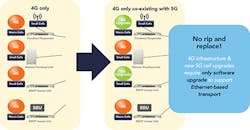Preparing for 5G-Ready Mobile Transport —
Wireless operators today face significant challenges as they prepare their networks for the looming re-architecture required to support 5G. The 5G networks of the future promise a range of bold performance targets that will revolutionize the wireless industry as well as many additional industries that will be able to capitalize on new network capabilities.
Qualcomm Chief Executive Officer Stephen Mollenkopf recently described the possible impact of 5G during his keynote speech at this year’s Consumer Electronics Show (CES), stating that "5G will be a new kind of network, supporting a vast diversity of devices with unprecedented scale, speed and complexity. 5G will have an impact similar to the introduction of electricity or the automobile, affecting entire economies and benefiting entire societies."
There is huge industry excitement around 5G, but standards will not be finalized for a number of years, meaning operators will face a period of uncertainty, continuing to scale today’s networks while also preparing for 5G.
Innovation Required in All Areas
5G will require innovation in all aspects of wireless communications, including handsets, wireless networks, and chipsets, to support 5G-enabled devices, and applications such as self-driving cars, swarms of delivery drones, or just smart kitchen appliances. A key factor here is the significant architectural changes required in the underlying optical transport networks.
Today these networks are predominantly Ethernet-based mobile backhaul that connect cell sites back to the mobile core network, although many operators are also evaluating or deploying mobile fronthaul networks too. Mobile fronthaul networks use a very different protocol, Common Public Radio Interface (CPRI), to connect a remote radio head (RRH) attached to a cell tower to a baseband unit (BBU) that has been moved from the cell site slightly deeper into the network to a BBU hotel. A BBU hotel is a location where several BBUs are clustered together to serve a group of cell sites. These networks are limited to around 20 kilometers (km) of reach for latency reasons, and the BBU is still connected to the core via a backhaul network.
Fronthaul networks are deployed in some regions of the world for purely economic reasons, where the Cloud radio access network (C-RAN) architecture can result in lower space and power costs in cell sites. In some other regions, such as North America and Europe, C-RAN is required to support the more advanced wireless network functionality found in the most recent 4G standards.
5G Standardization Is On Its Way
The main standardization body for the wireless industry is the 3rd Generation Partnership Project (3GPP), which unites 7 telecommunications standards development organizations in order to enable joint development of wireless standards. 3GPP started work on their Release 15 (part one of the 5G standards) standardization in 2017 with completion scheduled for the latter part of this year, with Release 16 (part two of the 5G standards) following toward the end of 2019.
Commercial deployments of true 5G networks could start to happen as quickly as 12 months after these dates. The organization first standardized 4G in 2008 with its Release 8 Long Term Evolution (LTE) specification, and continued to develop this with the addition of LTE-Advanced (LTE-A) standardization in Releases 10 and 11. 3GPP continues to evolve the 4G specifications and add new capabilities, with the most recent Release 14 specification due to be finalized in 2017.
These 4G specifications play an important role in 5G networks, as unlike in earlier network generational changes, 5G networks will include existing 4G infrastructure. Many of the recent 4G updates are in preparation for 4G’s supporting role in 5G networks.
So, while there is a lot of excitement in the telecom industry and many others around the potential of 5G, the major challenge that network operators face is that standardization isn’t set and won’t be for some time. We do, however, have a good idea of what mobile transport networks will look like even though we are sometime away from the exact details.
What Do We Know About 5G Architectural Changes?
Beyond the obvious changes in the radio access network (RAN), handsets, and supporting chipsets, networks will require several significant architectural changes:
Support for software-defined networking (SDN) and network functions virtualization (NFV). 5G embraces the current trend toward SDN and NFV, and future 5G mobile transport networks will need to fully support SDN control and interaction in NFV environments.
"Cloudification" of networks. Many 5G-based applications will rely on simpler wireless devices that utilize the network to offload functions to preserve battery life or enable more complex operations on simpler, lower-cost hardware.
The transition from Cloud to fog. As 5G brings in very low latency requirements for some services and applications, the data centers used to create the mobile Cloud will need to be distributed, with some large data centers serving a large area, and some mobile sites closer to the user becoming mini data centers to support "fog" networks and mobile edge computing (MEC).
Network sliceability. In order to support differing service profiles, networks will need to be sliced to support separate domains over the same infrastructure. This will enable applications to sit above a sliced control plane and sliced forwarding plane as if they were discrete networks with differing performance metrics. This enables operators to carve out a slice of the network dedicated to a function, such as supporting autonomous vehicles, knowing it has the necessary resources, or for a network to be logically shared between multiple operators.
Coexistence with 4G. To support the higher performance requirements, 5G cells will be significantly smaller than today’s 4G cells. While some areas will have multiple 5G cells to replace a 4G cell, many areas will have mixed coverage or only 4G cells. These 4G cells will require upgrades to the mobile transport network to ensure that 4G and 5G cells can be managed over a common mobile transport network. (See Figure 1.)
Figure 1. 4G and 5G Cell Coexistence. (Source: Infinera)
What Does All This Mean for Mobile Transport?
Mobile transport networks will need to support higher throughput, lower latency, and the architectural changes, outlined above. Mobile fronthaul and backhaul will also merge into a combined network, sometimes called midhaul or crosshaul (X-haul), to give a common transport network to all cell sites. This network will include a new variant of Ethernet called Time-Sensitive Ethernet that will be able to switch traffic based not only on priority but also on the latency sensitivity of the information, which enables Ethernet to replace CPRI in mobile fronthaul scenarios.
In parallel to this, 3GPP has proposed a model with 8 options for functional splits covering the possible blending of fronthaul and backhaul capabilities in the future. At one extreme, there is fronthaul, which is essentially the transmission of a digitized version of the analog radio frequency (RF) signal. This results in minimal processing at the cell site, but can support only limited reach of 20 km due to latency limits, and requires significantly more bandwidth than mobile backhaul. At the other extreme, there is Ethernet-like transmission.
There are also many possible options between the 2 extremes. 3GPP is discussing how to take this model forward, but at a minimum, it will result in changes to the protocols carried in the mobile transport network.
Getting Ready for 5G Now
5G is on its way, but wireless network operators don’t have the luxury of pausing while products are developed to support the new standards. Standardization is still some time away, and bandwidth continues to grow rapidly. Network operators need to continue to invest in fronthaul and backhaul infrastructure to support this continued growth. However, they need to ensure they evaluate platforms with the flexibility to adapt as protocols and network architectures evolve to support 5G. 5G-ready mobile transport offers the ability to avoid the need to rip and replace network hardware as 5G becomes standardized, giving operators 4G investment protection. (See Figure 2.)
Figure 2. 5G-Ready Mobile Transport. (Source: Infinera)
The next few years look to be an exciting time for wireless networks and all the associated parties involved in making 5G a success. There will be winners and losers in this transition, as there always are in situations like this, and optical networking vendors can help by providing as much flexibility and investment protection as possible.
Save







